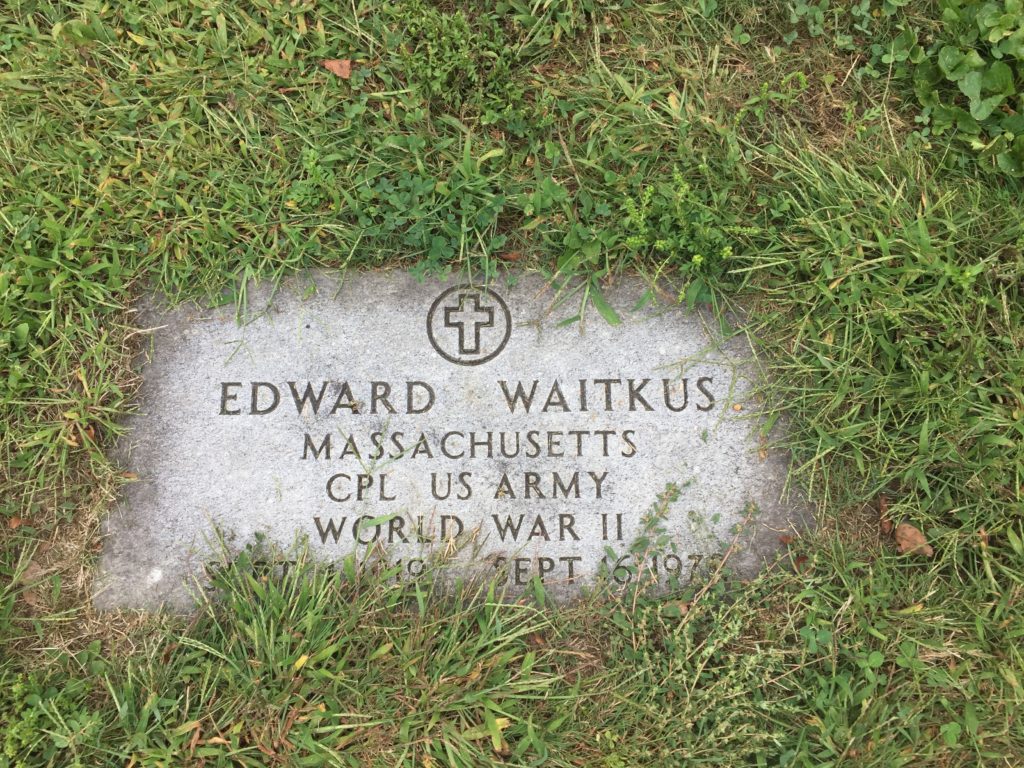Erik Visits an American Grave, Part 629
This is the grave of Eddie Waitkus.

Born in 1919 in Cambridge, Massachusetts, Waitkus was the son of Lithuanian immigrants. A very skilled baseball player, he started playing professionally in 1938, with a semipro team in Lisbon Falls, Maine that was basically a team of textile employees for a local factory. He rose quickly and the Chicago Cubs signed him, bringing him to the majors in 1941. This was the end of the season and he received only 28 at-bats, which he didn’t do anything with. But his skill was so obvious that he received a nickname: “The Natural.”
Waitkus’ career was interrupted though by World War II. He missed the entire 1942-45 seasons and fought in the Philippines among other places, receiving four bronze stars. Brutal stuff and he was very lucky he survived. In 1946, he returned to the Cubs, where he became one of the team’s most popular players. He was a good interview and had a likable personality. He also spoke five languages fluently: English, French, German, Polish, and Lithuanian, which in a city like Chicago didn’t hurt. He was a solid, but not great player. He was a first baseman with no power, which is not ideal. But his first season back, he hit 304/340/408 and finished 13th in the NL MVP voting. He dipped from this in 1947 but was an All-Star in 1948. This was easily his best season, according to Baseball Reference’s WAR stat, where he had a 3.2, the only season where he cleared 2.5 For those of you that care about these things, that’s basically a low-range starting player but well short of what one would expect of someone who gets named to the All-Star Game.
At the end of that season, the Cubs traded him to the Phillies. He was an All-Star in 1949 for the Phillies. But although he was having his best year to that point, hitting 306/403/426, though with all of 1 home run, that was something of a honorific thing. That’s because on June 14, The Natural was shot by an obsessed fan named Ruth Ann Steinhagen, while the Phillies were in Chicago playing the Cubs. This was one of the first modern cases of criminal stalking. She had been a fan ever since he was with the Cubs, but it seems she freaked out when he played for the Phillies because she couldn’t see him every day. She started stalking him. She left him a note at the team hotel after figuring out the name of a former high school classmate to lure him to her room. He walked in and she shot him in the chest. He was lucky to have survived World War II. He might have been even more lucky to have survived this as the bullet just missed his heart. Steinhagen instantly called the front desk and then held him as the doctors arrived. He nearly died several times on the operating table. Crazy stuff. She spent three years in a mental institution and then lived in seclusion for the rest of her life, dying in 2012.
Amazingly, Waitkus was back in uniform for a night in his honor in August. When he returned to full-time action in 1950, he was basically OK, but not great. His power was even more limited by then, hitting 284/341/359, which somehow still got him MVP votes, finishing 24th that year. He was named Comeback Player of the Year, for obvious reasons, and led the team in runs. Moreover, this was the Whiz Kids who won the NL pennant that year, before getting stomped by the Yankees in the World Series. But he was basically a decent average, no power first baseman for the rest of his career. He continued playing with the Phillies through the 1953 season. In 1954, the Baltimore Orioles purchased his contract for $40,000. He played that year and the first part of 1955 with them. When they released him midseason, he returned to the Phillies but had nothing left and retired at the end of the season.
Waitkus worked in baseball for the rest of his career, including as an instructor at Ted Williams’ baseball camp. But he died of esophageal cancer in 1972, at the age of 53.
Of course, what makes Waitkus known today, other than the shooting itself, is the Bernard Malamud novel, The Natural, that was inspired by the shooting. Of course Malamud really took liberties with the story, expanded it to include stuff inspired by the Black Sox scandal in 1919. Other than the shooting itself and of course the nickname that was used for the book title, there’s really no connection between the story of Roy Hobbs and Eddie Waitkus. But the book, Malamud’s first, made the young writer’s reputation and of course was later made into the excellent Robert Redford film.
Eddie Waitkus is buried in Cambridge Cemetery, Cambridge, Massachusetts. For what it’s worth, Malamud is buried across the street in Mount Auburn Cemetery. According to Baseball Reference’s JAWS stat, Waitkus is the 168th best first baseman of all time. For contemporary reference, twenty-first century first basemen around this number include Kevin Millar (163rd) and Doug Mientkiewicz (169th). If you would like this series to visit other middling first basemen around Waitkus’ quality, you can donate to cover the required expenses here. George “Firebrand” Stovall, who played mostly for the Indians in a career that extended from 1904-15 and who is 170th on the list, is in Burlington, Iowa and the legendary Jiggs Donahue, who played between 1900 and 1909, mostly for the White Sox, is in Springfield, Ohio. Previous posts in this series are archived here.


